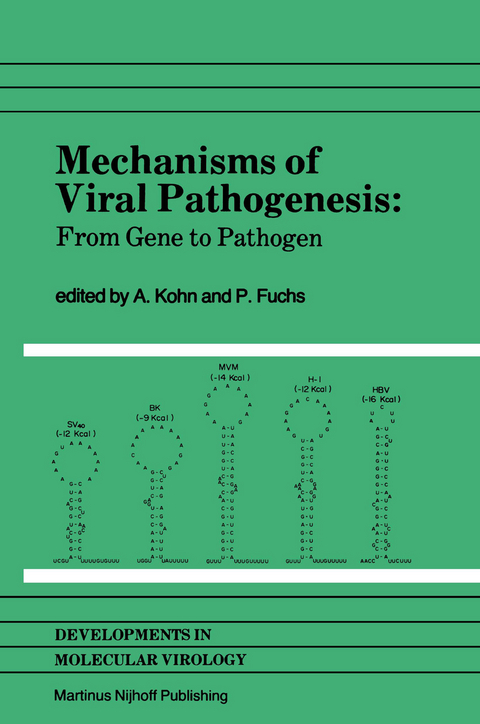
Mechanisms of Viral Pathogenesis
Springer-Verlag New York Inc.
978-1-4613-3896-3 (ISBN)
The virion has an envelope which contains blO glycoproteins: E2 of 5F,000 daltons (gp56) and E1 of ~O,OOO daltons (gp50) (5,6). Viral neutralization (N) and hemagglutiration (HA) sites have been placed on E2 by the use of monospecific rabtdt antisera and monoclonal antibodies specific for purified viral structural proteins (7-10). Only anti-E2 antisera neutralized virus infectivity or blocked virus hemagglutination.
Opening Lecture.- 1 Attentuation in the Control of Gene Expression in Animal Viruses.- Reassortment of Viruses with Divided Genome.- 2 The Use of Reassortant Bunyaviruses to Deduce Their Coding and Pathogenic Potentials.- 3 Genetic Diversity of Buynaviruses and Mechansisms of Genetic Variation.- 4 Variations In Rift Valley Fever Virus.- Molecular Mechanisms In Acute, Persistent and Latent Infections.- 5 Pathogenic Aspects of Murine Coronavirus Infection In Rats.- 6 Persistent Paramyxovirus Infection In Vitro and In Vivo.- 7 Factors Involved In Measles Virus Persistence.- 8 Mechanism of Adeno-Associated Virus Latent Infection.- 9 Host Range Transition of Lymphotropic Minute Virus of Mice During Persistent Infection In L-Cells.- 10 Transplantation of Mouse Genes into Rat Cells Chronically Infected by Moloney Leukemia Virus (M0-MuLV).- Promoters in Pathogenesis.- 11 Transforming Genes of Retroviruses and Cancer Cells.- 12 Control Elements for the Expression of DNA Tumor Viruses.- 13 Non-Expressed Tumor Virus Oncogenes Can Be Activated by Tumor Promoters.- 14 Rearrangement and Activation of a Cellular Oncogene.- 15 Pathogenicity of Vesicular Stomatitis Virus Is Potentially Mediated by Wild-Type Leader RNA which Inhibits Initiation of Transcription.- 16 Structural Features of Picornavirus RNA Involved in Pathogenesis: A Very High Affinity Binding Site for A Messenger RNA-Recognizing Protein.- 17 Molecular Approach to Virulence: Isolation and Characterization of Avirulent Mutants of Rabies Virus.- Cleavae of Glycoprotein In Pathogenesis.- 18 Studies on The Structure and Activities of Influenza Virus Haemagglutinin.- 19 On The Role of Viral Envelope Proteins in Pathogenesis.- 20 On The Pathogenicity of Avian Influenza Virus.- 21 Glycoproteins of Venezuelan Equine Encephalitis(VEE) Virus: Molecular Structure and Function in Virus Pathogenicity and Host Immunity.- Viral Enzymes In Pathogenesis.- 22 Isolation and Characterization of the Viral RNA Dependent RNA Polymerases from Cells Infected with Either the Mahoney or Sabin Attenuated (LSc,2ab) Strains of Poliovirus Type 1.- 23 Herpes Simplex Virus Type 1 Thymidine Kinase Controls Virus Pathogenesis and Latency in the Nervous System.- 24 Round Table Discussion.- Author Index.
| Reihe/Serie | Developments in Molecular Virology ; 3 |
|---|---|
| Zusatzinfo | XXII, 330 p. |
| Verlagsort | New York, NY |
| Sprache | englisch |
| Maße | 155 x 235 mm |
| Themenwelt | Medizin / Pharmazie ► Medizinische Fachgebiete ► Mikrobiologie / Infektologie / Reisemedizin |
| Studium ► Querschnittsbereiche ► Infektiologie / Immunologie | |
| Naturwissenschaften ► Biologie ► Mikrobiologie / Immunologie | |
| ISBN-10 | 1-4613-3896-4 / 1461338964 |
| ISBN-13 | 978-1-4613-3896-3 / 9781461338963 |
| Zustand | Neuware |
| Haben Sie eine Frage zum Produkt? |
aus dem Bereich


